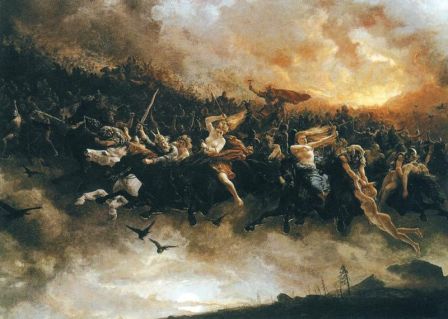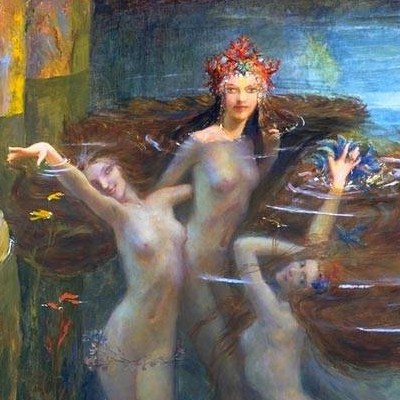
“Vasudhara” by Sundar Sinkhwal
“Vasudhara’s themes are religious devotion, charity, thankfulness and abundance. Her symbols are cows and golden items. In India, this golden-breasted earth Goddess provides us with enough abundance to be able to give back freely of what we receive. Vasushara’s golden color alludes to some solar attributes, including manifesting financial prosperity for those who call upon Her. In Her wealth-giving aspect, Vasudhara sometimes appears as a cow.
Around this date, many churches in the United States and Canada begin their annual fund-raising campaign by asking parishioners to give back a little of what the divine has given them. While many New Age practitioners don’t belong to a church, this idea still holds merit and would please Vasudhara greatly. Donate a little money to a pagan defense fund, for example. Put on something gold to draw the Goddess’s prosperity back to you, then buy some good magic books for your library. The proceeds indirectly ‘give back’ to the teachers whom you admire through royalties!
If your schedule allows, stop in at your favorite New Age store and volunteer an hour of your time to give back to the community. Write thank-you letters to people who have somehow touched your life deeply. Should any of these people live nearby, help them with chores or bring them a special dish for dinner. These acts of kindness are a type of stewardship that reflects Vasushara’s spirit by blessing others.”
(Patricia Telesco, “365 Goddess: a daily guide to the magic and inspiration of the goddess”.)

A Newari Representation of Vasudhara
From Wikipedia: “Vasudhārā whose name means ‘stream of gems’ in Sanskrit, is the Buddhist bodhisattva of wealth, prosperity, and abundance. She is popular in many Buddhist countries and is a subject in Buddhist legends and art. Originally an Indian bodhisattva, Her popularity has spread to southern Buddhist countries. Her popularity, however, peaks in Nepal where She has a strong following among the Buddhist Newars of the Kathmandu Valley and is thus a central figure in Newar Buddhism. She is named Shiskar Apa in Lahul and Spiti.
The origin of Vasudhārā in Buddhism appears in the Buddhist text The Vasudhara Dharani. According to a legend in the text known as ‘The Inquiry of the Layman Sucandra,’ an impoverished layman named Sucandra approaches the Buddha Shakyamuni requesting a way to obtain large amounts gold, grain, silver, and gems in order to feed his large family and engage in acts of charity with the surplus fortune. Shakyamuni, aware of a mantra about the bodhisattva Vasudhara that would suit his purposes, bestows Sucandra with an incantation and religious ritual that when followed would result in good fortune and prosperity brought on by Vasudhara Herself. Upon commencing the rituals and teaching them to others, Sucandra begins to prosper. Noticing his success, the monk Ananda asked Shakyamuni how he had obtained this fortune so quickly. Shakyamuni instructs Ananda to also practice the Vasudhara Dharani and ‘impart it to others ‘for the good of many’.’
Although ‘The Inquiry of the Layman Sucandra’ seems to contradict the Buddha’s renunciation of material possessions and earthly pleasures, Shakyamuni does not instruct the monk to recite the mantra for material benefit but instead he stresses that the mantra is for ‘the good of many’ and for ‘the happiness of many’. Thus the mantra is meant more as means of alleviating suffering rather than obtaining wealth through Vasudhara, who not only grants physical wealth and abundance but also spiritual wealth and abundance. Click here to continue reading about Her legends from Taranatha.
Like the legend of the ‘Inquiry of the Layman Sucandra’ these legends are significant because they encourage both the lay and monastic worship of Vasudhara. In addition, they stress the importance of charity, teaching worshippers to share in their good fortune rather than amassing it for themselves.

Vasudhara [Tib. Norgyun(ma)]
In
Buddhist art, Vasudhara has a consistent iconography. She can easily be identified as a bodhisattva by the elaborate headdress and the extensive amount of jewelry she wears. Her skin has a golden hue in bronze and painted images. This color is associated with precious metals and symbolizes opulence, fertility, and generosity in Buddhist iconography. Vasudhara is typically seated on a lotus flower base in the lalitasana, or royal pose, with one foot tucked in towards her and the other hanging of the flower base but resting on a small treasure. She can, however, also be represented in a standing position. When standing, Vasudhara has a full vase representing abundance underneath each foot.
Despite this consistency in Her representations, the number of Her arms may differ from image to image. In visual representations, Vasudhara can have as few as two arms and as many as six. The two-armed representations are more common in Tibetan art and Indian art, while six-armed representations are almost exclusive to Nepalese art. Although the six-armed image originates in India, they are rare and only few examples have been found.
In Her hands, Vasudhara holds a variety of objects attributed to Her. Most representations show Her holding a sheaf of corn in Her left hand, symbolizing an abundant harvest. She may also be holding a gem or small treasure, a symbol of wealth. Representations with more arms, such as the six-armed Nepali representation, also depict Her holding a full vase and the Book of Wisdom. With Her free hands, Vasudhara performs mudras. A commonly seen mudra in paintings and figurines featuring Vasudhara is the varada mudra, also known as the charity mudra, which symbolizes the ‘pouring forth of divine blessings.’ Vasudhara is the subject of numerous bronzes and paintings. She is predominantly the central figure of bronze sculptures or painted mandalas. She may also, however, appear alongside Her consort, Vaiśravaṇa (Jambhala) the Buddhist God of Riches. Despite his status, She surpasses him in popularity and is more commonly the central figure of Her own mandalas.
Vasudhara is particularly popular in Nepali Buddhism among the Buddhist Newars of the Kathmandu Valley. In this region she is a common household deity. This is known from the countless number of bronzes and paintings found representing Her. These images are small in size, typically 18 cm or smaller. Because of their small size it is known that these images were primarily for private use, namely household veneration of the Goddess. Additionally, there is a cult dedicated to Her worship followed by the Buddhist Newars. Followers of this cult believe that Her worship brings wealth and stability. Despite the strong following of this cult by the Buddhist Newars, unfortunately, it is now in decline.
As the Bodhisattva of abundance and prosperity, Her popularity in this region is due to the predominance of agriculture and trade essential to the economy of the Kathmandu Valley. The Newars believe that Her veneration will generally result in good fortune.
 One of the earliest Nepalese representations of Vasudhara is a pauhba (textile art depicting Hindu and Buddhist images on course cotton), dating back to 1015 C.E. This pauhba is known as the Mandala of Vasudhara. The Goddess is the central image of this mandala, which depicts scenes of dedication, ritual initiation, festive music, and dance associated with Her worship. Its purpose is didactic (to teach). The mandala teaches the importance of worshipping Vasudhara primarily through the narrative of a non-believer whom She converted to belief.
One of the earliest Nepalese representations of Vasudhara is a pauhba (textile art depicting Hindu and Buddhist images on course cotton), dating back to 1015 C.E. This pauhba is known as the Mandala of Vasudhara. The Goddess is the central image of this mandala, which depicts scenes of dedication, ritual initiation, festive music, and dance associated with Her worship. Its purpose is didactic (to teach). The mandala teaches the importance of worshipping Vasudhara primarily through the narrative of a non-believer whom She converted to belief.
In addition to Her popularity in Nepal, Vasudhara is also an important ‘wealth deity’ in Tibetan Buddhism. Although popular in Tibet, Vasudhara does not assume as important of a role as She does in Nepalese Buddhism. In Tibet, the worship of Vasudhara is limited to mostly lay people as opposed to worship by both lay and monastic life. This is because Tibetan monastic life regards Vasudhara as a ‘benefactor of the laity’ and instead primarily engages in the worship of the Goddess Tara for all their needs. This, however, does not mean that monastic life disregards Her completely. They do perform rites and rituals to the Goddess habitually but it is usually at the request of a patron.
The iconography of Vasudhara varies slightly in this region. In Tibetan art She appears more commonly with two arms. The six-armed representations, however, also exist and it is believed they filtered into Tibet through Nepal because of the late appearance of these images in manuscripts and art. Unlike Nepalese art, Vasudhara rarely appears alone in Tibetan art. Instead She is paired with Jambhala or appears alongside other deities. Despite these slight differences, most of Her iconography remains unchanged and Vasudhara can be easily recognized by Her attributes in most Buddhist art.
 Vasudhara is often compared to the Hindu goddess Lakshmi. As Goddesses of wealth, both deities have a similar iconography and are worshipped for their role in an abundant harvest. Both assume a golden hue in artistic representations, perform the same mudra, and hold similar objects. For example, Vasudhara and Lakshmi are often depicted holding gems or having pots of treasure under their feet. It is believed that the convention of depicting Vasudhara standing on vases originated from earlier representations of Lakshmi. Furthermore, both Goddesses are often depicted paired with their respective consorts, Lakshmi alongside Vishnu and Vasudhara alongside Jambhala.” [1]
Vasudhara is often compared to the Hindu goddess Lakshmi. As Goddesses of wealth, both deities have a similar iconography and are worshipped for their role in an abundant harvest. Both assume a golden hue in artistic representations, perform the same mudra, and hold similar objects. For example, Vasudhara and Lakshmi are often depicted holding gems or having pots of treasure under their feet. It is believed that the convention of depicting Vasudhara standing on vases originated from earlier representations of Lakshmi. Furthermore, both Goddesses are often depicted paired with their respective consorts, Lakshmi alongside Vishnu and Vasudhara alongside Jambhala.” [1]

“Invite Vasudhara into your home, offer Her flowers and water, and recite Her mantra daily to invite wealth and abundance into your life. Her mantra is: OM SHRI VASUDHARA RATNA NIDHANA KASHETRI SOHA.” [2]
Sources:
Fsmegamall.com, “Bejeweled Vasudhara – Goddess of Wealth and Abundance“.
Wikipedia, “Vasudhara“.
Suggested Links:
Huntington, John C. & Dina Bangdel. The Circle of Bliss: Buddhist Meditational Art, “125| Vasundhara“.
Isley, A. Krishna. Krishna76.deviantart.com, “Vasundhara in Vajrayana Buddhi“. (An excellent academic essay!)
News.richmond.edu, “Religion professor researches Buddhist goddesses of Tibet“.
Shaw, Miranda Eberle. Buddhist Goddesses of India.
Smithsonian Institution. Asia.si.edu, “Devi: The Great Goddess“.
































![42909139[1]](https://journeyingtothegoddess.files.wordpress.com/2012/10/429091391.jpg?w=260&h=448)











